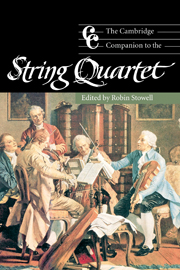Book contents
- Frontmatter
- Part I Social changes and organological developments
- Part II Celebrated ensembles
- Part III Playing string quartets
- 5 Playing quartets: a view from the inside
- 6 Historical awareness in quartet performance
- 7 Extending the technical and expressive frontiers
- Part IV The string quartet repertory
- Notes
- Select bibliography
- Index
6 - Historical awareness in quartet performance
from Part III - Playing string quartets
Published online by Cambridge University Press: 28 September 2011
- Frontmatter
- Part I Social changes and organological developments
- Part II Celebrated ensembles
- Part III Playing string quartets
- 5 Playing quartets: a view from the inside
- 6 Historical awareness in quartet performance
- 7 Extending the technical and expressive frontiers
- Part IV The string quartet repertory
- Notes
- Select bibliography
- Index
Summary
String quartet performance might at first seem an unpromising area for the practice of historical awareness. After all, there is no mystery about the instruments required and the musical texts are so explicit that there can be little room for radical re-interpretation. Yet the huge amount of music written in the first seventy or so years of the string quartet's existence was played on instruments substantially different from their modernised twentieth-century successors. The Classical repertory from Haydn to Schubert and the even more numerous contributions from their lesser contemporaries were written for instruments and bows whose construction reflected their historical position midway between the late Baroque and the early nineteenth century. And although the opportunities to decorate or alter the notes on the page became increasingly rare as the eighteenth century progressed, the manner in which these notes were played was also far removed from conventional twentieth-century practice.
The early quartets
An indication of the historical and stylistic location of the early quartets of the mid eighteenth century is given by the fact that several of their composers also produced collections of trio sonatas, a Baroque form then on its last legs. The variety in this early quartet repertory is reflected in its range of titles, from ‘quartetto’ to ‘cassatio’. The content of these works ranged from straight fugues through simple sonata forms to light divertimento movements. Two sets stand out. One of the earliest references to a quartet party is in the autobiography of Dittersdorf, where he recalls tackling ‘six new quartets by Richter’.
- Type
- Chapter
- Information
- The Cambridge Companion to the String Quartet , pp. 127 - 148Publisher: Cambridge University PressPrint publication year: 2003

